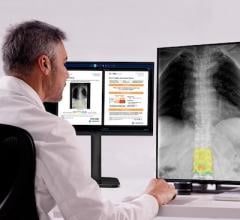
May 24, 2023 — Since the launch of ChatGPT in November 2022, the use of large language models (LLMs) powered by artificial intelligence (AI) has taken the world by storm. Now, researchers have investigated the potential of using these types of AI tools in the field of clinical radiology. What are the potential benefits and drawbacks? What are the ethical implications? A discussion paper in the Journal of the American College of Radiology (JACR), published by Elsevier, puts ChatGPT to the test and opens the discussion on the various aspects of its use.
"The potential use of AI-powered chatbots like ChatGPT is a promising and disruptive area of research that has the potential to revolutionize the practice of radiology," explained lead author Ramin Javan, MD, Department of Radiology, Director of Advanced Brain Imaging and 3D Innovations Lab, George Washington University Hospital, Washington, DC, USA.
The goal of this investigation was to present the idea that chatbots can serve as assistive tools at the intersection of medicine and technology to free professionals in the field from some mundane and repetitive tasks, allowing them to focus more on high-level and specialized endeavors, maximizing their potential as specialists, allowing individual talents to thrive, and benefiting patients.
"Once we tried different prompts and were able to fine tune the results to obtain the final response we were looking for, we were convinced that we are truly looking at a defining moment in the evolution of human-machine synergy," Dr. Javan continued. "We decided to dive deeper and open a conversation around the potential benefits that chatbots could bring to patients, radiologists, and the entire medical community. At the same time, we felt it was important to address the challenges and ethical considerations that come with using these advanced technologies in a sensitive and critical field like healthcare. Our goal was to initiate an engaging and unbiased discussion, while showcasing the capabilities of ChatGPT itself."
Coauthor Ahmed Ismail, BA, George Washington University School of Medicine, added, "With imagination being the primary constraint, we illustrate how AI-powered chatbots, like ChatGPT, can support the shift of clinical radiology to a patient-centered model without placing a greater strain on radiologists or medical infrastructure. We further discuss how this technology could be a valuable tool for radiology education."
The paper, partially written by ChatGPT itself, highlights the following positive and negative aspects:
Positive considerations:
ChatGPT can:
- Simplify medical reports for patients, enhancing patient-centered care.
- Aid patients before radiologic-guided procedures by providing information, assessing readiness, and offering support.
- Be used as an education and training tool for radiologists.
- Support a patient-centered model in clinical radiology without straining existing resources.
- Augment content creation, such as literature search, content organization, and translation.
Negative concerns:
- Accuracy and reliability concerns, especially with the "hallucination" problem.
- Transparency challenges in understanding how ChatGPT works and generates outputs.
- Privacy concerns regarding the protection of patient data.
- AI systems like ChatGPT should not replace human expertise and judgment.
- Ethical implications of AI-generated content in research and publications.
This discussion is particularly important at this time because AI-powered chatbots are rapidly gaining popularity and are being integrated into various applications, including within the medical field. The ethical implications revolve around the accuracy, transparency, privacy, and potential misuse of AI-generated content.
"AI-powered chatbots like ChatGPT hold great potential to transform clinical radiology, enhancing patient care, and radiologist education,” noted coauthor Nima S. Ghorashi, BS, George Washington University School of Medicine, Radiology Interest Group President. “However, it is crucial to address the ethical concerns and ensure these technologies are used responsibly, complementing the expertise of medical professionals, and not replacing them. It is all about balance."
When prompted, what did ChatGPT say about ethical implications? "While ChatGPT and other AI systems may potentially improve the efficiency and accuracy of certain tasks, they are not capable of replacing the expertise and judgment of trained healthcare professionals. It will be important to ensure that these systems are used in a way that complements and enhances human expertise rather than replace it."
Dr. Javan sees great potential in deploying LLMs to aid with scientific article writing. He envisions that this process can be significantly augmented by using ChatGPT as a virtual assistant in steps such as literature search, generation of tables/graphs, content paraphrasing/organization, journal readership/style adaptation, and possibly even translation for non-native English speakers. "Using ChatGPT in this way enables individual to dedicate more time to development of new ideas and making more impactful contributions."
Ahmed Ismail commented, “With each passing day, we uncover new possibilities to weave AI-powered technology into the fabric of medical practice. As imaging experts, radiologists must have a seat at the table to appropriately harness this technology and steer its potential towards enhancing patient care.”
For more information: www.elsevier.com
Related ChatGPT content:
ChatGPT Passes Radiology Board Exam
JNM Explores Potential Applications for ChatGPT in Nuclear Medicine and Molecular Imaging
New Research Suggests AI Image Generation Using DALL-E 2 has Promising Future in Radiology


 December 24, 2025
December 24, 2025 









